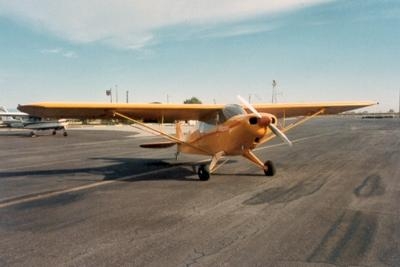Wed, Jul 09, 2014
Airplane Went Down July 2 Near Anchorage, AK Fatally Injuring The Pilot
The NTSB has determined that the elevator cables on a Piper PA-12 that went down July 2 shortly after takeoff from Merrill Field Airport, Anchorage, AK were incorrectly installed, according to a preliminary report.

The report indicates that the accident occurred about 0820 Alaska Daylight Time. The accident resulted in the fatal injury of the pilot and substantial damage to the airplane.
According to acquaintances of the pilot, the airplane had been undergoing extensive maintenance for about 5 years. Neither the airplane's co-owner nor others at the airport were aware of it having been flown before the accident flight. A pilot who was standing on the ramp on the south side of runway 25 saw the airplane climb after takeoff. He said that, once the airplane became airborne, its climb kept getting steeper and steeper and did not level off like he expected it would. He said that the airplane "wasn't pitching quickly or violently but slowly" and "as if the pilot had no ability to stop it." The climb appeared so abnormal to the witness that he yelled to get the attention of another pilot on the ramp. He said that the engine sounded strong during the climb. He said that the airplane then pitched down, and he heard the engine power reduce as if the pilot had pulled it to idle, and the airplane descended vertically to the ground.
A second witness who was also on the south side of runway 25 described that the "airplane's angle of attack was so steep" that he knew "something was not right." He said that the airplane climbed straight up then "pivoted" to a nose-down position and descended straight to the ground. The witness said that he heard the engine go quiet about the time that the airplane pivoted, but he was not sure if the engine noise changed before or after the airplane transitioned to the nose-down attitude. The two witnesses and several other people from both sides of the runway ran to the accident site to try to help. Two witnesses who were east of runway 25 reported hearing engine noises that sounded like back-firing.
The airplane was righted and towed from the accident site for an examination. At the request of and in the presence of the NTSB investigator-in-charge (IIC), an airframe and powerplant mechanic assisted with the examination of the airplane.

The engine and the damaged front control stick were removed to allow for movement of the flight controls. The postaccident examination revealed that manipulating the ailerons resulted in correct directional movement of the rear control stick. Manipulating the rudder resulted in correct directional cable movement to each rudder pedal.
The elevator control cables were attached to each end of the elevator control horn. Elevator control cable continuity was established from the control horn to the rear control stick. Manipulating the rear control stick aft (to command airplane nose-up) resulted in cable movement corresponding with a downward deflection of the elevator (which would result in airplane-nose-down flight). The airframe and powerplant mechanic assisting with the examination confirmed that the elevator control cables were misrigged, such that they were attached to the incorrect (opposite) locations on the elevator control horn, resulting in a reversal of elevator control inputs.
(Photo from file. Not accident airplane)
More News
Airport Rotating Beacon A visual NAVAID operated at many airports. At civil airports, alternating white and green flashes indicate the location of the airport. At military airports>[...]
Aero Linx: Fly for the Culture Fly For the Culture, Inc. is a 501(c)(3) non-profit organization that serves young people interested in pursuing professions in the aviation industry>[...]
Klyde Is Having Some Issues Comprehending The Fed's Priorities FMI: www.klydemorris.com>[...]
Also: Viasat-uAvionix, UL94 Fuel Investigation, AF Materiel Command, NTSB Safety Alert Norges Luftsportforbund chose Aura Aero's little 2-seater in electric trim for their next gli>[...]
Also: EP Systems' Battery, Boeing SAF, Repeat TBM 960 Order, Japan Coast Guard H225 Buy Despite nearly 100 complaints totaling millions of dollars of potential fraud, combined with>[...]
 ANN's Daily Aero-Term (04.25.24): Airport Rotating Beacon
ANN's Daily Aero-Term (04.25.24): Airport Rotating Beacon ANN's Daily Aero-Linx (04.25.24)
ANN's Daily Aero-Linx (04.25.24) Klyde Morris (04.22.24)
Klyde Morris (04.22.24) Airborne 04.24.24: INTEGRAL E, Elixir USA, M700 RVSM
Airborne 04.24.24: INTEGRAL E, Elixir USA, M700 RVSM Airborne 04.22.24: Rotor X Worsens, Airport Fees 4 FNB?, USMC Drone Pilot
Airborne 04.22.24: Rotor X Worsens, Airport Fees 4 FNB?, USMC Drone Pilot




